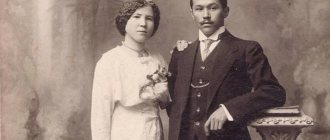What wedding rituals existed in Rus'? What is boot removal? what is the bride's headdress intended for? how the wedding with trumpets took place; what is dissection of young; where did the custom of kidnapping brides and the word “betrothed” come from? We read about this and much more in the description of the Russian wedding ceremony by the ethnographer M. Zabylin.
***
It seems that there is not a single more solemn feast in the world that can be compared with the wedding ceremony, the beginning and consummation of marriage, the beginning and crown of love, about which young heads wax poetic several years before, choosing in their imagination a suitable ideal until they find it. Each nation has its own views and customs on the marriage ceremony. But both young men and women in Rus' (from the common people), despite all the simplicity of their simple way of life, understand what the eternal connection bestowed by a crown means; a connection with an unrecognized person, often with a vicious one, completed with a crown - inextricably until the end of the life of one or the other. All girls understand this before marriage, but they count on marriage like a lottery, which is known to be not always reliable.
Girls are known to resort to fortune telling, often very unwise; orphans in Radonitsa go to the graves of their parents to say goodbye and ask for blessings on their fate. Pokrov and Friday Praskovya are considered patroness of brides among the common people. Brides, caring about their future and a good life (no one wants anything bad), during the holiday of the Intercession they pray: “Father Intercession, cover my head!” In Red Rus' they sing:
Holy Pokrovonka Cover your little head!
Here we express the outline of the desire of young people who are looking for a means to achieve marriage or simply get married without any deliberate desires, but only because they do not lag behind their peers. Young girls are still embarrassed when counting years, and the one who comes out earlier triumphs, as if she had won, but this does not mean the well-being of life.
I. S. Kulikov “Ancient ritual of blessing the bride in the city of Murom.” 1909
In different countries of northern Russia, wedding ceremonies are very diverse and numerous, to the point that they present extremely lively pictures in general, and, moreover, very diverse in their characteristics. Here the most complete ethnographic picture with its beliefs and rituals is presented, and what is most important, here is the symbol and allegory of rituals that are already lost in the folk sense and exist only by execution, as a custom. This folk play, repeated daily, is generally interesting, since nowhere is it best characterized as in weddings; here you hear and see life and fun, touching and soul-touching features from folk life and those religious customs with which all these rituals are merged. Here the old merges with the new, the religious with the folk, and the sad with the cheerful.
The custom of kidnapping girls
This custom, according to Nestor, existed among the Russian Slavs, for example, among the Radomichs, Vyatichi, and Severians there were games between villages, that is, between fields, and not between villages: here, during games, songs and dances, men chose brides for themselves and were taken to their homes. In remembrance of this pre-Christian custom of Ancient Rus', we still have an ancient song of sifting, beginning like this: “And we sowed millet, we sowed”... The Drevlyans took the girls to themselves, just as the Romans did in ancient times with the Sabines. The very expression of playing a wedding is reminiscent of the ancient games that began the acquisition of brides.
Persecution of customs by the clergy
During weddings in the old days, there were always jokers (jokers), organics, and guselniks (guslars). This custom still exists today; More than once the Church rebelled against such orders, which are direct traces of paganism, and wanted to separate all customs before and after the wedding, but this could not be eradicated, since the very act, based in its future on love and harmony, on family happiness, caused for fun.
In addition to the pagan element that remained in wedding rituals, this also included customs from other peoples in later times.
Greek and Roman rites
In Greek and Roman marriage rites we find wreaths, wedding rings, veils (like our veils or veils), joining of hands, candles, wedding gifts, etc. Indeed, how similar these are to Christian rites during the marriage itself. Venus, as the patroness of marriages and unions of love, was called Suada and Babia (svada and babia), we invite readers to share with us their opinion whether they find similarities in the word svada with a wedding, and in the word babia - baba. This is not enough: Russian customs say that even today young people are showered with hops, grain and even money; the meaning is clear: for the young to live happily, well-fed and richly; but where did this custom come from? Again from the Greeks and Romans, as well as from the ancient Prussians.
Speaking about the borrowing of customs by Russians, we cannot help but say that the Russian loaf as a symbol of marriage was also borrowed from the Romans. Among the Romans, as is known, newlyweds during a solemn wedding must eat a cake made from flour mixed with salted water and honey.
Fortune Teller
It was believed that chips, relief and cracks on wedding rings would attract misfortunes and troubles into the family life of the newlyweds. Tamara Solntseva
Only those girls who were getting married for the first time could wear a veil, since this attribute was considered a symbol of purity. Even earlier, the veil was replaced by an almost opaque shawl. The bride put it on when leaving her parents' house and did not take it off until her marriage, since it was believed that during this period she was left without protection and vulnerable to evil spirits, and under the shawl they would not be able to find her.

Wedding rings
There were also special requirements for wedding rings. They could be made of any material, but one thing remained unchanged - the surface should be smooth, without relief, stones, chips or scratches.
During the period from the moment of matchmaking to the wedding, the bride had a lot of worries. First of all, she needed to embroider a towel, which would be used during the blessing, and then remain in the newlyweds’ family, as a talisman against grief and misfortune. The shirt was also embroidered by hand, which the groom then wore to the wedding.
Groom's concerns
The young man also had his own preparations for the wedding, although not so scrupulous - he needed to collect a rich bouquet for his beloved. There were no florist shops before, so plants were obtained from the gardens of relatives and neighbors, and they could not refuse the groom. He presented the collected bouquet to the bride on the wedding day, and then the girl chose the most beautiful bud from there and attached it to her betrothed’s shirt. This is a prototype of a wedding bouquet and boutonniere, but now the bride is unlikely to entrust her lover with the choice of a flower arrangement, since it must be combined with the whole image as a whole.
The groom was traveling behind his future wife on the ceremonial train. There were no railways in the villages; this is simply a symbolic name for the procession, in which, in addition to the young man himself, his brothers, friends and relatives, except his parents, went out. They stayed at home to make final preparations for the celebration.
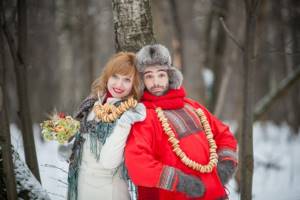
Along the entire route he was given obstacles, for example, in the form of a cart in the middle of the road. The groom bribed enterprising neighbors with wine, home brew, sweets or coins. In the bride’s house, by the way, they also did not open the gates voluntarily for him, and sometimes they also hid the bride, giving her away only for a significant ransom.
Wedding
A wedding in the literal sense of the word was considered a wedding in a church. Now this ritual can be called additional to the official painting, and it can be performed or not performed as desired. Previously, those who did not get married were not officially considered husband and wife, and if a man and woman lived together without this ceremony, then it was considered sinful. They carefully prepared for this sacrament, choosing suitable outfits, which were then considered magical. During the wedding, the newlyweds cemented their decision to start a family in the eyes of God.
When the young people left the church, the guests showered them with grain - oats, barley, millet, etc. Thus, friends and relatives wished the newly-made spouses prosperity and well-being. Nowadays, rice, small coins or rose petals are used instead of grain, but the traditional Russian wedding ceremony has already lost its original meaning.
Feast
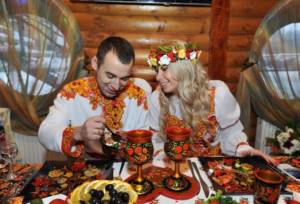
The favorite part of everyone present at a wedding is the feast. In Rus', it was hosted by the groom's parents, and almost all the women from the village could be involved in preparing the treats. The priority was not only to demonstrate one’s financial well-being, but also to feed all the guests to their fill. Considering that the celebration lasted for several days in a row, the groom's parents had a lot of worries and expenses.
During the feast, many different Russian wedding rituals and customs took place, but we can note one of the most striking - the joint breaking of dishes. The newlyweds and their guests purposefully broke clay pots and jugs.
Interesting!
Removing the boot
In Russian indigenous custom, it was and still is in some places that the newlywed should take off her husband’s shoes. This custom in ancient times, generally speaking, depicted submission, a slavish attitude, even humiliation, because who takes off another’s boots if not a person who has completely submitted. From history we know that this custom existed even in the time of Vladimir and that the daughter of the Polotsk prince did not want to take his shoes off.
In Germany, during the time of Luther, there was the same custom: on the first night of marriage, the young wife took off her boot and placed it on the sky of the bed (at the head) as a sign of the dominance of the husband over the wife, of the man over the woman (enslaved).
Omarius and Gerbenstein say that during their stay in Moscow, even at princely and boyar marriages, the custom of taking off shoes and hitting them three times with a whip was performed, which was placed in a casket along with the gift. This ritual continued in Lithuania until Jagiellon and is still preserved in peasant life.
Marten at a wedding
Old wedding customs probably also mention some pagan legend. Marten in wedding customs is a monument to Norman taxes. If you say “kuna, kona” (kona, kuno), which means a woman, this is expressed in history, a gathering of newlywed peasants and commoners in general. The marten, as we will see, has remained an essential unit in our folk songs of a wedding nature. In southern Russian songs, the bride is sometimes likened to a black marten, and the groom to a black sable.
We must remember from history that in Russia, before the introduction of metal coins, the object of money was mainly furs; hence the words arise: kuna, half-kuna, half-ear (half, small copper coin). If metal coinage subsequently appeared, then, of course, the comparative assessment was also reproduced and, as one must think, the censure of the account was retained as it existed with leather money.
Hence the comparison of young people with a marten, then with a sable as an assessment of merits, and now we have: “If he takes a look, he’ll give him a ruble.”
It was known not only in Russia, but throughout Europe, maiden marten, wedding marten - an expression consistent with the meaning of payment for the bride, an expression equal to the meaning of serfdom and the enslavement of women[1]. Which still exists in some provinces of Russia.
Wedding ceremony and traditions of the ancient Slavs
The ancient Slavs took all important events very seriously. Each holiday was preceded by a series of preparations. Each action had its own secret meaning, absolutely everything was interconnected. There were no empty dances and songs; behind every step, behind every lunge of the hand and sound, there was a message into space, to higher powers. The ancient Slavs believed in the flow of forces, in energy, so they took every step very deliberately. What can we say about the wedding? Firstly, no one took such a step out of the blue, even despite their feelings. The universe does not tolerate haste. The lovers took a long time to decide on this step, as did their parents. Starting a family was considered one of the most important actions in a person’s life. Two destinies and two lives were linked forever. Family, in the minds of the ancient Slavs, was an unbreakable bond. Even after death, the souls of the spouses continued to remain connected. This was the case in all worlds and dimensions. Therefore, it is no wonder that such a serious step required complete confidence on the part of the young people in each other and their own feelings, as well as a whole series of rituals to tie together the life streams of the future spouses.
Let's start with the name of the wedding celebration itself. In the old days it was called Lubomir. There is no need to guess at all to understand the meaning of this name. Love and Peace are fundamental concepts in the minds of the ancient Slavs. The combination of the male and female divine principles gave birth to the universe, this was due to love. In nature, everything is arranged in such a way that different polarities attract, and as a result something new happens. This attraction for our ancestors was love - the desire for a new life. The union of a man and a woman predicted the emergence of new life and the fulfillment of the main mystery of the universe. Therefore, the marriage itself was called Lyubomir, two people created their own world and became like gods - creators. By the way, this name had three different meanings: it was a holiday that was celebrated every year, a wedding ritual, and marriage itself. Lubomir was strong and was created to last a lifetime. There were few possibilities to terminate it, except perhaps the death of one of the spouses, or some other reason out of the ordinary. This testifies to the extremely serious attitude and respect of the ancient Slavs towards the institution of marriage and family.
In the old wedding rituals there was no hint of fights, drunkenness and other indecencies. Our ancestors did not drink alcohol in any form. All rituals were performed in a sober mind, and the ancient Slavs did not have to drink to have fun. Looking at how weddings are celebrated today, the author desperately wants to return to the pagan past. The ancient Slavs sang and danced, and organized various games and competitions, and did not disgrace themselves with indecent behavior. This is very important to remember, because our ancestors considered Lubomir a spiritual celebration, and first of all everything was done to please the soul, and then the body. That is, the point of the wedding was not to eat to your heart's content, get drunk as hell, and then shout obscene ditties at the top of your lungs.
By the way, the tradition of wedding rings existed in the old days, but it was more multifaceted and complex. It wasn’t like the guy just came to the bride’s house and, amid the screams and screams of the guests, put a ring on the betrothed’s finger. Both sides carefully prepared for this action since adolescence. As soon as a boy or girl turned twelve, well, maximum sixteen years old, they began to wear a silver ring. Silver because, firstly, this metal was considered the most sacred and pure among the ancient Slavs, and secondly, our ancestors believed that it was silver that could fully absorb all human energy. So, when the betrothal took place (by the way, it is worth noting that the very name of this action comes from the word “hoop”) the bride and groom exchanged rings. But contrary to today's traditions, the rings were not worn on the hands, but hung on the neck, closer to the heart. With such an engagement necklace, the betrothed were supposed to spend from sixteen to forty days (apparently the decision on the period was made by the sorcerer). This time was allotted so that the young could absorb the essence and energy of their loved one. The engagement, by the way, could take place in private, away from prying eyes, or in the presence of family and friends. In any case, both families knew about what was happening, and parental blessing on both sides was considered a necessary factor for the betrothal to take place. On the day when Lyubomir was celebrated, the bride and groom put on each other new rings, which were made by the master of the family. The new ring was placed on the ring finger of the right hand. Old rings were returned to their original wearers and placed on the ring finger of the left hand. Thus a spiritual circle was closed between the spouses, hand to hand.
The wedding celebration was not accompanied by such stupid rituals as ransom. Lubomir, as previously mentioned, had a spiritual purpose, and such base and pitiful concepts as money simply could not exist there. Of course, the future head of the family had to be able to support his wife and children, but in no case did this become a determining factor, saying that whoever is richer will give his daughter to him. The man himself, his spirit, his will, and his actions were much more valued. The groom could even take part in specially arranged competitions with brothers, father, or other relatives of the chosen one. It could have been battles, although they fought with wooden implements so as not to injure or accidentally kill someone, but the fight was in full force. This was how a man’s physical fitness was tested, because he had to be able to protect his family from physical threats. They often hunted together to test how successful and skilled the groom was. The girls also had to work hard, because they had to compete with the female half of the groom's family. Knowledge of handicrafts, cooking and household maintenance was valued. Of course, the ability to sing and dance was also encouraged, but the woman was primarily interpreted as a mistress and keeper of the hearth, not as a singer and dancer. Of course, modern women will only snort at all these facts, but earlier people had completely different thinking and understanding of female and male purpose. The author will not judge what is bad and what is good, but will only say what is good when everything has its place and purpose. Everything is the will of heaven.
The reader may ask, what would a holiday be without a round dance?! Of course, there was one on Lyubomir, and not an ordinary one, but a very special one. In the evening, when the main part of the celebration was over, people moved closer to bodies of water, to the river, for example. A fire was lit there. Usually two fires were built for young people. One of them was intended for a round dance of girls, and the second for a round dance of boys. It is worth noting that the movement of the girls’ round dance took place in the direction of the sun. This was called salting. But the round dance of the young men moved in the opposite direction, that is, in the opposite direction. Even here, the sacred meaning of the understanding of the feminine and masculine principles by the ancient Slavs is hidden: the masculine principle rebels against nature, and is characterized by the manifestation of strength and aggression, while the feminine principle, on the contrary, creates and multiplies. The combination of these two principles gives balance and true unity, complementing each other everywhere. The bonfires themselves, around which the round dances took place, were located in such a way that at one specific point, the dancers touched each other’s backs. The sorcerer gave a sign and the round dances froze for a moment, so that upon contact, the young man always found himself opposite the girl. It was these two who were taken out of the round dance, then the movement resumed and moved smoothly until another pair was formed again. There should have been nine such pairs. Then, the girls and boys were placed so that their backs touched. Then they had to say the name of all three worlds (that is, Reality, Rule and Nav) and then turn their heads. If both turned their heads in the same direction, then it was believed that there was a spiritual connection between such people. This did not mean that the boy and girl necessarily had to get married, but it could be a sign of friendship, spiritual union and patronage, as between brother and sister.
Wedding birds
Even in paganism among the Lithuanians, on the first day of the wedding, the husband tore apart the fried partridge brought to his bed, part of which he gave to his wife to eat.
In the Middle Ages, the Germans gave newlyweds fried chicken, which was called marriage or love chicken. Fried chicken (evening smoke) was served to newlyweds on the first day in Russia, as can be seen from the descriptions of ancient weddings of the 15th century. In Moscow, to this day, young people are given a pair of live geese in ribbons, and even sometimes swans, and in the old days, fried swans were served on the tables of princes. There is a popular belief that swans are the only thing newlyweds can eat.
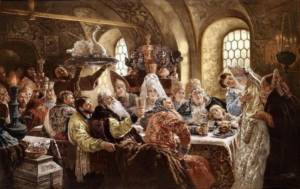
Konstantin Makovsky. Boyar wedding feast in the 17th century
Wedding walk
After registering the marriage, the guests (often only young friends and girlfriends of the newlyweds) go for a walk around the city. At the same time, they try to visit the most beautiful sights in order to take pictures there.
Seven Bridges
We have all seen the groom carry the bride across the bridge. It turns out that this ritual also applies to wedding customs and traditions in Russia.
It is believed that if the newlyweds cross seven bridges on their wedding day, their marriage will be strong. It rarely happens that a couple manages to go around all seven bridges, but everyone tries to cross at least one.

Also, a padlock with the names of the newlyweds is often hung on the bridge, which, according to legend, seals the marriage.
Bread and salt
Traditionally, after the wedding, newlyweds come to the house of the groom's parents, where they meet them with bread and salt.
Usually the new mother-in-law holds a loaf of bread on a towel (a special towel), from which the bride and groom must take a bite. Whoever bites off the most will be the head of the family.
Wedding traditions and customs of the Russian people these days are losing touch with religion: previously, the groom’s parents used to bless the newlyweds in this way, and the groom’s father kept icons for this. Loaf for a wedding is a tradition that originated from here.
Now the wedding loaf is greeted at the restaurant where the banquet on the occasion of the celebration will be held.

Bridal headdress
It is known that in Russia, the newlyweds put a kokoshnik, kokuy or kika on their head, and unravel the braid in two with well-known songs. This custom, apparently, was adopted from the Tatars, as Pleno Karpin and Brunna think; but Grim says that the Germans also had a custom for a newlywed not to let her hair down, but to tie it on her head and cover it with a cap. Tertullian says that the pagans had the custom of appearing to women covered, the Jews had the same custom, and among the Russians the veil still represents a symbol of bashfulness and modesty. Therefore, we can conclude that all our ancient rituals, partly disappeared, partly existing today, do not have the full character of news or originality, but rather borrowing through influence from other peoples.
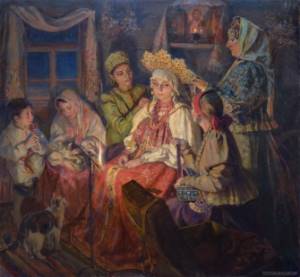
Maria Molodykh. Bride
Bath, furs and straw of the wedding night
Among the folk customs that existed even in royal and boyar houses were: washing in a bathhouse on the eve of the wedding and after it, also laying sheaves of rye instead of a bed and sitting the newlyweds on fur.
Washing in the bathhouse expressed the purity of the marriage bed and cleanliness in general, sleeping on sheaves signified income in the house, and sitting on furs signified wealth. Such customs still exist today.
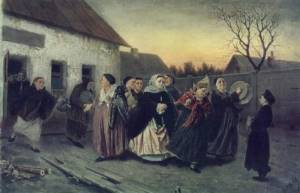
V. Perov. On the eve of the bachelorette party. Seeing the bride off from the bathhouse
Wedding songs in relation to their meaning
Who doesn't know, who hasn't heard wedding songs? Who doesn't understand their meaning? All this is very simple to the point of naivety. Among the Romans, girls sang songs until midnight near the newlyweds' bedroom. And among Russians, the entire wedding ceremony is accompanied by chants, as can be seen from the magnifications and songs during the wedding, bachelorette party, etc.
The character of these songs generally expresses preparation for the duties of a wife and housewife, a depiction of married life, and sometimes an expression of a girl’s melancholy at the memory of how, willy-nilly, she must leave her parents’ house. In general, so-called wedding songs contain marks of ancient customs, and in some choruses Lado, Tur and Lel are mentioned as Slavic gods of love and joys. They contain the blue sea, combustible stone, towers and light rooms, broken tablecloths, baked loaves, sugar dishes, hryvnias, and so on. and thereby indicate their ancient origin.
How does this happen these days?
Essentially, what are modern Russian wedding rituals?
Let's outline it briefly. A young man proposes to his chosen one, in most cases relegating such events as “asking the bride’s parents for her hand in marriage” and “receiving a parent’s blessing” to the background. And it happens that he does not resort to such actions at all.
After the bride accepts the groom's proposal, active calculations begin to determine how much this celebration will cost. An application is submitted to the registry office, which allows you to determine the exact date of the wedding. The bride, with the help of her bridesmaids, chooses her wedding dress, jewelry and shoes. The responsible person, the toastmaster, is responsible for the wedding scenario itself. Usually she is not related to either the groom's side or the bride's side.
Immediately before the wedding, events such as bachelor and bachelorette parties take place.
And finally, this day comes - the wedding. With or without a visit to the church, the newlyweds arrive in their cortege to the doors of the registry office, where the main wedding ceremony takes place. And only after both parties sign the marriage is considered valid.
Betrothed
The origin of this word must be derived from fate, which sends the groom to the bride. The very word “bride” means unknown, unknown, already points to that Russian custom when the groom could see the girl only after the crown as a newlywed, in the same way the bride of his betrothed, since both young people were married according to the will not of their own, but of their parents . From here it is clear that, in the old days, calling the wedding “the Judgment of God,” they saw in this rite the unknowing combination of young people forever, until the grave, placing their hopes on God, who Himself in this case awards them the marriage crown.
Wedding rituals of Ancient Rus' that no longer exist
Matchmaking
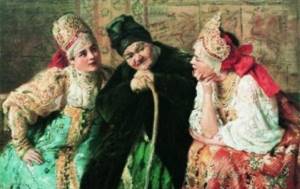
Matchmaking is not only the unexpected arrival of the groom, accompanied by relatives, to the bride’s house in order to woo in an allegorical form (show himself and look at the goods). Matchmaking was the starting point from which the rebirth of the main participants in the wedding ceremony, the bride and groom, literally began. From the moment of the betrothal, the bride (the bride) was subject to restrictions on movement, her living space was sharply narrowed to the confines of her parents' home. If a girl went out, it was only accompanied by her friends and, in fact, only to invite guests to the wedding. The bride was also removed from all household chores and became incapacitated. This is how the gradual “dehumanization” took place, necessary for the birth of a new person, already a family one.
Bride
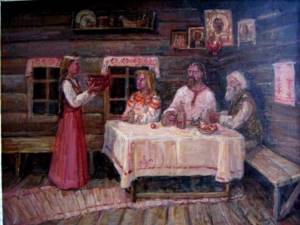
Two or three days after the matchmaking, the groom and his close relatives again come to the bride’s house, now for the bride’s viewing, during which the girl must show herself in all her glory and demonstrate all her skills and abilities, just like the groom, who shows off in front of by all those gathered. After this, the groom's mother closely examines and evaluates the bride's dowry. Everything that happens is necessarily accompanied by songs and lamentations, most often performed by the bride’s friends. However, the girl could refuse marriage without going to the groom.
Handshake
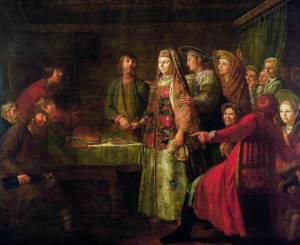
Shortly before the planned wedding day, there was a handshake or a drinking session, an event that finally sealed the agreement on the wedding. After the handshake, refusing the wedding was impossible. The bride and groom were seated side by side at the table and celebrated in songs performed by the bride's friends.
But what do the bride and groom themselves do? The bride does not speak, but laments, and in some houses they even call the woman who “howls,” that is, performs laments, and the bride groans and cries. And, despite the visible activity of the groom, his constant movements (he comes to the bride’s house almost every day after the hand-waving for “visits”, “kisses”, “visits”), he still remains passive: the matchmakers speak and do everything for him, relatives, friends.
hen-party
Has this ritual also disappeared? The fact is that a bachelorette party in Rus' is not only the farewell gatherings of the bride with her friends on the eve of the wedding, but also the making of “beauty” (“will”), unbraiding the braid, washing the bride in the bathhouse, destroying or transferring the “beauty” to a friend or groom. Girlish “beauty” is the last thing that connects the bride with her girlhood. It could be a tow, a tree decorated with ribbons and rags, a wreath, or a scarf. After making the “beauty,” it was burned or the bride distributed it to her close friends. Whatever the object symbolizing “beauty,” it is invariably associated with the head, more precisely hair, and hair is a kind of personification of girlish beauty and will. With the destruction or distribution of “beauty,” the girl was allegorically deprived of her girlhood.
Also, the bride could cut off her braid and pass it on to the groom. And the ritual ablution in the bathhouse finally completed the process: the bride became: “neither alive nor dead,” and in this state she was handed over to the groom, bargaining was arranged, and the bride and her friends resisted with all their might.
Young woman's hairstyle
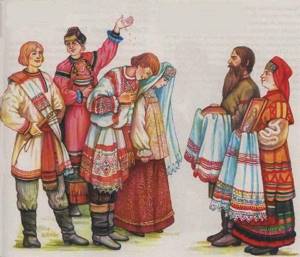
Immediately after the wedding, the bride was given a young woman’s hairstyle: they braided two braids and covered her head with a scarf, or immediately “twisted them like a woman”: the hair braided in two braids was twisted at the back of the head into a bun, and a married woman’s headdress was put on top (povoinik, ochtok, nametka) . From that moment on, only the husband could see the bride’s hair: appearing bareheaded to a stranger was tantamount to treason, and tearing off a woman’s headdress was an insult. A change in hairstyle means the girl’s transition to the power of her husband, and also represents the formation of a new appearance of a person, his rebirth in a new status. The girl begins to “come to life”: she regains the ability to move independently, as well as the ability to do everything with her own hands: the bride, entering the house, begins to actively explore its space, throws rye, puts down a cow, throws a belt, etc.
"The Bride Revealed"
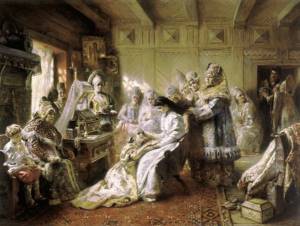
A special ceremony was dedicated to the “unveiling” of the bride, when the newlyweds came from under the aisle to the groom’s house. This ritual was endowed with a double meaning: for the bride it meant the return of vision; the bride, continuing to come to life, now looked at everything with different eyes, and for the groom this was a kind of recognition of his beloved, since she was now different. In some details of the ritual, an erotic meaning is read when the bride is “opened”: the father-in-law or groomsman lifts the hem with a whip, grip, pie or stick. Or they placed a pie without filling on the bride’s head, symbolizing a child, and wrapped it in a scarf, putting it in a closet, where the newlyweds first ate separately from everyone else, and then spent their wedding night. In some areas, it was the custom to arrange a bed for newlyweds in a cage or stable, which is associated with the idea of fertility and childbirth.
"Diversions"

“Otvodiny” (joint visit of the bride’s parents to the young) marks the end of the wedding as a special state for all its participants. This element of the wedding ceremony is especially important for the bride, who comes for a short time and as a guest, which emphasizes the irreversibility of all the transformations that happened to her during the wedding. However, there are other data about the bride’s connection with her home. For example, in the Voronezh province, during the first year of marriage, a young woman lived with her mother and was engaged in spinning for her future needs.
Wedding lamentations, voting
There is a superstition that the bride needs to cry on her bachelorette party and before the wedding, based on the old saying: “If you don’t cry at the table, you’ll cry behind the post.” In some localities, lamentations or voting still exist to this day, for example, according to Professor Snegirev, in Verkhovozhsky Posad, Svatanye, a bride, covered with a veil, among her maiden friends, sits on an elevated place with a skillful lamenter and begins to lament, that is, speak in a sing-song voice, a decent word or greetings to father and mother, brothers, sisters and all relatives, says goodbye to her home and, if she is extradited to a foreign land, then to her friends.
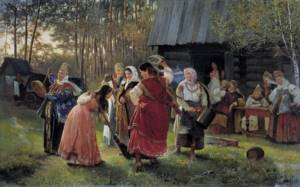
A.I. Korzukhin. Hen-party. 1889
Pre-wedding and wedding ritual
Each ritual in the wedding procession had its own strictly designated time and sequence. In general, the entire celebration with all the accompanying preparations lasted for a couple of months. Each locality had its own unique customs and nuances, but in general all rituals were divided into two types: pre-wedding and wedding. The first group included the following events: matchmaking, bridesmaids, engagement, loaf baking, bachelorette party and gala evening. Let's look at each of them in more detail.
Matchmaking.
When the bride was chosen and feelings were tested, it was the turn to meet the chosen one’s parents and ask for their consent. Before this, of course, the groom announced his intention to his parents. They usually came to get married in the evening, right up to the night. There was an intention here, if the groom was given a turn - a turn, then he could leave the girl’s house unnoticed. This would not cause unnecessary gossip and gossip. Here concern was shown not only for one’s own position, but also for the girl’s position. Usually the groom was accompanied by his two closest and trusted friends. They had to use all their skills and abilities in order to win over the owners of the house. First, the conversation took place with the girl’s parents so that they could evaluate the groom. Only after his candidacy had been previously approved by the household, was the girl herself called in for a conversation and asked for her opinion. A note to modern young ladies from the author - the girls were asked for their opinions, which means they were valued as individuals, and there were no misogynists. Of course, the opposite probably also happened, but in most cases the girl could, if she wanted, refuse the marriage if the boy was not nice to her.
Bride.
After matchmaking and reaching agreement on the part of the bride and her parents, it was the turn of the groom and his family to appear in a favorable light. Parents and close relatives gathered and went to visit the groom's house. Of course, there is no denying that this campaign had a material motivation. The girl’s parents had to make sure that the groom was a working man who would be able to support his family in the future, despite all the difficulties. The young man should already have his own farm. You cannot and should not accuse our ancestors of commercialism, because kissing under the moon alone will not satisfy you.
Engagement.
After the matchmaking and viewing, it was necessary to make it clear to those around, in particular the rest of the boys and girls in the settlement, that the bride and groom were no longer free for unnecessary antics and frivolities. The groom and his family got ready and went to the bride's house, where, according to custom, a table rich in treats was set. The bride and groom were seated together, and their hands were tied with towels. This meant the betrothal itself, after which it was no longer possible to refuse the wedding without bringing shame on the family. Moreover, the refusing party had to pay the second family for the so-called “moral damage”.
Baking a loaf.
The loaf is generally a symbol of Slavic hospitality. Our most respected and long-awaited guests are still greeted this way - with a loaf of bread and salt in their hands. The loaf was a symbol of home and comfort. It’s no wonder that the future housewife had to be able to bake this pastry. Our ancestors turned baking a loaf into a real sacred ritual. It took place in the bride's house, where all married relatives gathered. Their number had to be odd; according to the beliefs of our ancestors, this was a lucky omen. They baked a loaf of bread, accompanying all this with songs and dances. In a word, the Slavic women organized gatherings (oh, these women, just give them a reason).
Bachelorette party and evening of well done (bachelor party).
Before Lyubomir's day, the bride and groom gathered their closest friends to spend the last day of their old, single life. It was a kind of farewell to childhood, youthful carefreeness and lightness. Family did not mean shackles for the ancient Slavs, but it was regarded as a huge responsibility that required no small courage and fortitude. This was spiritual maturation for the spouses, and such last evenings were a way to say goodbye to the past and begin a new chapter in their lives.
Thus, all pre-wedding preparations ended. By the way, during this entire time, both the bride and groom were obliged to fast in order to cleanse the body and spirit before starting family life. The wedding itself, that is, Lubomir, consisted of several stages. Let's look at each of them in more detail.
Dressing.
In the morning, after the ritual ablution, the bride and groom in their homes put on new clothes, mostly white, with many embroidered amulets, against all sorts of dark forces and misfortunes. Such clothes were usually made by women from young families themselves. The girl's dress had to be long, to the very floor, with wide sleeves. A scarf made of thick fabric was placed on the bride's head. All this strictness in clothing spoke of the girl’s purity and purity (yes, virginity was considered one of the most necessary qualities for a girl).
Requests, or invitation.
This was mainly done by friends of the future newlyweds. They invited guests and relatives to the holiday. There was a custom when the bride gave gifts to the guests.
Escorting the groom and ransoming the bride.
The parents “shooed” their son out of the house so that he could bring his bride. As for the ransom, everything is quite ambiguous here, as some sources claim that such an event was not held at Lyubomir.
Posad.
The name of this ritual comes from the word “plant”. When the groom came with his family to the bride’s house, they were seated at the table, and members of both families exchanged gifts in honor of the twinning.
Wedding.
The word itself comes from the word “wreath”. The Magus, in the presence of both families, friends and relatives, performed a ritual to unite the bride and groom, and at this time wreaths were placed on their heads. Usually the wedding took place in the temple of the goddess Lada, or in the temple of the god Svarog. However, this is not surprising, because who can bless the newlyweds better than the Forefather and Forefather of the universe themselves?! The best days for weddings were Friday, Saturday and Sunday.
Coating.
This was the most important stage in Lubomir. After the wedding, the scarf was removed from the bride’s head and some kind of headdress was put on. Before this, the now young wife’s braids were unraveled; in some corners, the braids were even cut off. This action took place in the father’s house, after which the husband took his new wife to his house. A new headdress meant a new status and new responsibilities for the girl. Now she was leaving her father's clan and becoming a member of her husband's clan. Even in the event of a marriage breakdown, a woman could no longer return to her old clan, since she was no longer part of it.
Transportation of dowry.
For each girl, from childhood, her family prepared a dowry - something that could be useful to the young housewife in a new home. Anything valuable could act as a dowry: money, livestock, a plot of land, bedding, furniture and much more. After the wedding, all this became the property of the husband, too, like his house, the property of his wife. This kind of equal exchange took place among our ancestors, and there was not a hint of pathetic commercialism.
Wedding with pipes
At the weddings of Russian tsars and important boyars, in addition to songs, zurnas were played with trumpets, as is known from the description of weddings in the 17th century[3]. Such weddings were called weddings with trumpets. Tsar Alexei Mikhailovich, during his wedding to Natalya Kirillovna, ordered that instead of trumpets and organs, his sovereign choristers, clerks, and all villages should sing alternately lowercase and deminical large verses from holidays and triodes, good verses, with all deanery. The songs and main wedding rites ended with the performance of the church ceremony.
Runaway weddings. Secret weddings. Rolled cigarette
Such weddings generally take place without the consent of the parents, so to speak, out of secret love and agreement of the young people, while there is no parental blessing and is not even expected. There are several pretexts for such a wedding: love between people who are unequal in status or wealth; the groom's cunning to take advantage of the bride's dowry, and often her capital, the girl's long celibacy - a boring life between sisters-in-law, persecution of the stepmother, and often - to cover up pregnancy. However, it also happens that parents often indulge in runaway weddings in order to avoid expenses.
In any case, the girl herself takes part in the escape and even, if she can, will even first convey her dowry through a faithful person to the groom, and then she will run away herself. In the groom's house, this wedding is considered formal.
After such a wedding, the newlyweds go to the bride’s parents, bow at their feet and ask for forgiveness. In some Volga provinces, the father hits the young people on the back with a whip and orders them to stand up, then forgives and blesses them with an image and bread and salt. Even if the young runaway did not take anything from her dowry, the bride’s parents give it away. However, there are also typical fathers, but even those over time give the assigned share to their daughter, who married with a rolled-up cigarette.
[1] Subsequently, kunas or martens were the name given in Lithuania to the chains in which girls were shackled at the entrance to a church for violating chastity [2] See p. 127 Rus. simple holiday and rituals. M., 1839 [3] See “The experience of narration about Russian antiquities” by G. Uspensky Part 1, 1818
Wedding ceremonies in Rus'
The sacrament of the wedding ceremony in Rus'
The basis of ancient Russian wedding traditions is the idea of a girl transitioning into the category of “woman,” taking into account the sacred meaning associated with this transformation.
Our ancestors sincerely believed that a girl died in her father's house in order to be reborn in her husband's family. Considering her “dead” during this period, the bride was covered from head to toe with thick fabric so that no one could see her face or even the lines of her silhouette. In such attire, the girl was led to the wedding, and only after the marriage was sealed by the priest, the veils were removed, and the newly-made wife independently went to her new home. Despite the adoption of Christianity, the Slavs were very superstitious at heart, so a pagan magical basis can be traced in many rituals. For example, the period after the wedding and before the first wedding night was considered extremely dangerous for the newlyweds, since they were hunted by evil forces. The young family had to take part in a number of rituals designed to protect them from damage, the evil eye, and witchcraft. For example, at a wedding there was a person who swept the road in front of the newlyweds so that they would not put a lining under their feet for quarrels or death. He also made sure that no one crossed the road for the spouses.
At the table, the young people ate and drank very little, purely symbolically drinking from a common cup after each toast, so as not to offend the guests. The newlyweds were supposed to sleep in a hay barn decorated with icons and arrows with martens located in the corners of the room. The bed was formed from sheaves of grain or wheat. In the morning, guests came in a crowd to the newlyweds to lift the blanket and check whether the bride was a pure girl or not. Sometimes a young mother could bring the sheets to the table, proving that she had raised an honest daughter.
Even in poor peasant families, celebrations lasted several days. On the first day, the bridesmaids prepared the bride to meet the groom, who then took the dowry and transported it to his home. After the parental blessing, close relatives of the future newlyweds knocked down tables, arranged dishes and food. And on the second day there was a wedding and a long feast, which ended with the wedding night. By the way, the groom had to remain silent these days in order to accumulate the strength to conceive a child. Therefore, the groom was entrusted with the responsibility of ensuring that the wedding took place in accordance with customs and rules.
Matchmaking and wedding preparations
Wedding ceremonies in Rus' were opened by the tradition of matchmaking - a ceremony during which the groom and his friends and relatives came to the bride’s house. There, the retinue, praising the guy in front of the girl’s family, asked for her hand in marriage. In order for the devils not to follow, the matchmakers had to come to the house by different roundabout roads, and the girl’s parents had to be refused, even if the young couple had been engaged since childhood.
When the matchmaking ended positively, a date was set for the bridegroom ceremony, a ceremony during which the groom’s financial and financial status was examined and his income was discussed.
If the bride's matchmakers were dissatisfied with the groom's property, they had every right to take back their words, since their main task was to ensure the future of their daughter. If the viewing was successful, a date was set for the official announcement of the wedding day, after which it was impossible to change this decision, of course, unless any force majeure situation occurred. The betrothal was necessarily celebrated with a magnificent feast.
The bachelorette party was organized two days before the wedding. The girls spent that night talking and singing. First, they went to the bathhouse to wash themselves properly and perform rituals designed to strengthen the love relationship between the couple, and then they went for a walk or went to visit the bride. At the bachelorette party, special rituals were necessarily carried out to protect the future young family, during which friends told that a terrible, unhappy life awaited the newlywed, and they also told fortunes and danced in circles. By speaking out loud about a bad future, Slavic women believed that they were scaring away evil spirits from home.
It is impossible to imagine weddings in Rus' without the traditional ceremony with a scythe, performed on the eve of the wedding. So, the bride and her bridesmaids unraveled her braid, casting spells, and braided her two braids. This symbolized the fact of saying goodbye to girlhood and the readiness to become a wife, woman, mother.
According to Slavic traditions, the groom did not throw a bachelor party. He was to spend this evening alone and in silence, although, like the bride, he should visit the bathhouse.
Ancient blessing ceremony
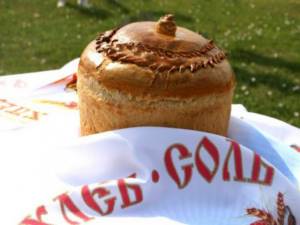
The ritual of blessing in Rus' was considered no less important than the wedding itself. During it, young people, before going to church, came to the courtyard where the bride lived, and there their parents met them, presenting them with bread and salt, and then christening them with a family icon wrapped in a towel. If parents did not give blessings, young couples could even separate.
wedding feast
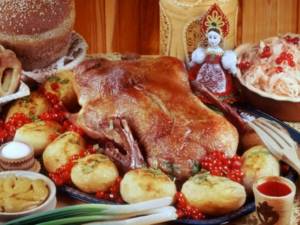
The newlyweds practically did not eat at the wedding table, much less drink, but only accepted congratulations and gifts from the guests. The serving of the last hot dish, roast, was accompanied by the couple leaving for the hay barn, where, according to tradition, their first night took place. But they were not always able to remain alone, since those invited had the right to call the newlyweds to the table, where the celebration continued.
In the morning, when sweets were served, the newlyweds got up and went to the bathhouse, and the bride’s mother showed the remaining tipsy guests sheets and shirts that proved the innocence of the young wife.
The celebration did not end there. On the third day, the wife was obliged to prove herself and show her skills. She lit the stove, washed the floors, prepared dinner, and at this time the guests joked at her, trying to throw her off balance.
Traditional wedding songs
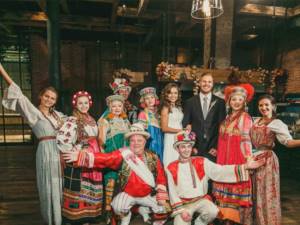
It is interesting that even during a peasant wedding, the newlyweds were called prince and princess, thus equating the sacrament of marriage with the enthronement of a king. And yet, not a single traditional Russian wedding was complete without chants that accompanied all the holidays.
Of course, most traditions and rituals have already lost their sacred meaning. In addition, modern people no longer take marriage so seriously, limiting themselves to a trip to the registry office or organizing a typically European or themed wedding. But still, there are newlyweds who prefer to formalize their marriage in accordance with ancient traditions, paying tribute to their past and preserving for posterity the memory of the age-old traditions of our people.









